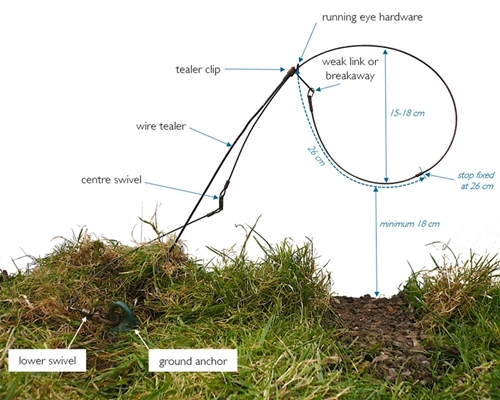Q: How does a snare work?
A: A loop of wire is set on a support (‘tealer’) at the appropriate height in a suitable place – for example in a ‘tramline’ made by tractors in an arable crop, which foxes may travel along. The head of the fox goes through the snare loop, which draws up to a fixed minimum size, thus restraining but not strangling the fox. The snare is anchored to the ground so the fox is held alive.

Q: Break-away device – how does that work?
A: This is a device on the cable that opens the loop if an animal stronger than a fox (such as a badger) pulls at the snare.
Q: Fixed stop – what does that do?
A: This prevents the loop closing beyond the size required to trap (but not kill) a fox. It also allows hares to self-release by pulling their heads out, and prevents the capture of an animal by the leg.
Q: Running eye – how does that work?
A: It is designed specifically not to lock and therefore allows the snare loop to expand with the movements of the captured animal (e.g. when breathing).
Q: Wire tealer – what does that do?
A: This is a temporary support that holds the snare loop at fox head height. Once an animal has been trapped, the snare releases from the support.
Q: Why are there two swivels?
A: These are to prevent separation of the cable by twisting, which can lead to subsequent breakage. Breakage can allow the animal to escape with the snare noose around its body, which can cause very poor welfare. The best position for the swivel (to relieve stresses in the cable) is considered to be near the ground anchor, but a second swivel is positioned further up in case the first one is buried under excavated soil or entangled with an obstacle.